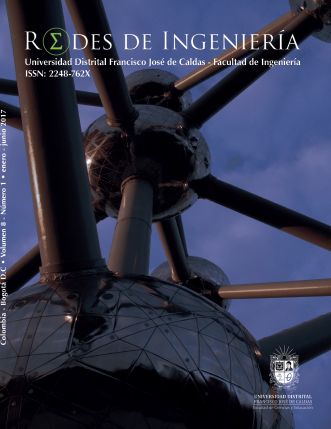DOI:
https://doi.org/10.14483/2248762X.10089Publicado:
2017-06-30Número:
Vol. 8 Núm. 1 (2017): Enero - JunioSección:
InvestigaciónAlgoritmo para la estimación de la frecuencia instantánea en señales de fase variante en el tiempo usando la transformación local polinomial de Fourier
Algorithm for the estimation of the instantaneous frequency in time-varying phase signals using the local polynomial Fourier transform
Palabras clave:
aproximación local polinomial, estimadores no paramétricos, frecuencia instantánea, periodograma local polinomial, transformación local polinomial de Fourier (es).Palabras clave:
instantaneous frequency, local polinomial approximation, local polinomial Fourier transform, local polynomial periodogram, non-parametric estimators (en).Descargas
Resumen (es)
La transformación local polinomial de Fourier (LPFT) es una representación tiempo-frecuencia (TFR) que generaliza los resultados obtenidos por la transformación de Fourier de corto tiempo (STFT); esta herramienta matemática puede ser empleada para estimar la frecuencia instantánea (IF) y sus derivadas en señales no estacionarias o señales de fase variante en el tiempo . Varias publicaciones presentan diferentes métodos para calcular la LPFT; sin embargo, estos trabajos no describen de manera completa un algoritmo para su implementación computacional o requieren del cálculo de funciones o transformaciones adicionales. Este artículo propone un algoritmo basado en la definición de la aproximación local polinomial (LPA) y el uso del periodograma local polinomial (LPP) como estimador de la IF y sus derivadas; asimismo, se presenta la validación del algoritmo propuesto y se consideran los errores (SRMSE) en el cálculo de los estimados de la LPFT. Finalmente, se determinan los costos computacionales a partir de un caso de estudio. Los resultados muestran que el error en el cálculo de la LPFT disminuye dependiendo del ancho de la función ventana y de la resolución dada a los posibles estimados de aunque esto provoque un incremento en la cantidad de operaciones realizadas.
Resumen (en)
The local polynomial Fourier transform (LPFT) is a time-frequency representation (TFR) that generalizes the results obtained by the short-time Fourier transform (STFT). This mathematical tool can be used to estimate the instantaneous frequency (IF) and its derivatives into non-stationary signals or time-varying phase signals. Several publications present different methods for calculating the LPFT. However, these studies do not fully describe an algorithm for its computational implementation or require the calculation of additional functions or transformations. This paper proposes an algorithm based on the definition of the polynomial local approximation (LPA) and the use of the polynomial local periodogram (LPP) as an estimator of the FI and its derivatives. Likewise, the validation of the proposed algorithm is presented and errors (SRMSE) are considered in the calculation of the LPFT estimates. Finally, computational costs are determined from a case study. The results show that the error in the LPFT calculation decreases depending on the bandwidth of the window function and the resolution given to the possible estimates, although this process causes an increase in the number of operations performed.
Referencias
M. Bollen y I. Gu, Signal processing of power quality disturbances. New York, USA: IEEE Press Series on Power Engineering, 2006. https://doi.org/10.1002/0471931314
J. Proakis y D. Manolakis, Digital signal processing: principles, algorithms and applications, 3rd ed. Prentice-Hall of India, 2000.
M. Bastiaans, “On rotated time-frequency kernels”. IEEE Signal Process. Lett., vol. 9, no 11, pp. 378–381, 2002. https://doi.org/10.1109/LSP.2002.805118
E. Sejdić, I. Djurović, y J. Jiang, “Time–frequency feature representation using energy concentration: An overview of recent advances”. Digit. Signal Process., vol. 19, no 1, pp. 153–183, ene. 2009.
V. Katkovnik, “A new form of the Fourier transform for time-varying frequency estimation”. En Proc URSI International Symposium on Signals Systems and Electronics ISSSE 95, 1995, pp. 179–182. https://doi.org/10.1109/ISSSE.1995.497962
X. Li, G. Bi, S. Stankovic, y A. M. Zoubir, “Local polynomial Fourier transform: A review on recent developments and applications”. Signal Processing, vol. 91, no 6, pp. 1370–1393, jun. 2011. https://doi.org/10.1016/j.sigpro.2010.09.003
V. Katkovnik, “Local polynomial periodograms for signals with the time-varying frequency and amplitude”. 1996 IEEE Int. Conf. Acoust. Speech, Signal Process., vol. 3, pp. 1399–1402, 1996.
V. Katkovnik, “Discrete-time local polynomial approximation of the instantaneous frequency”. IEEE Trans. Signal Process., vol. 46, no 10, pp. 2626–2637, 1998. https://doi.org/10.1109/78.720366
X. Li y G. Bi, “The reassigned local polynomial periodogram and its properties”. Signal Processing, vol. 89, no 2, pp. 206–217, feb. 2009. https://doi.org/10.1016/j.sigpro.2008.08.006
M. Z. Ikram, K. Abed-Meraim, y Y. Hua, “Fast Quadratic Phase Transform for Estimating the Parameters of Multicomponent Chirp Signals”. Digit. Signal Process., vol. 7, no 2, pp. 127–135, abr. 1997. https://doi.org/10.1006/dspr.1997.0286
G. Bi, Y. Wei, G. Li, y C. Wan, “Radix-2 DIF fast algorithms for polynomial time-frequency transforms”. IEEE Trans. Aerosp. Electron.
Syst., vol. 42, no 4, pp. 1540–1546, oct. 2006. https://doi.org/10.1109/TAES.2006.314595
G. Bi y Y. Ju, “Radix-3 fast algorithms for polynomial time frequency transforms”. Signal Processing, vol. 88, no 9, pp. 2316–2322, sep. 2008. https://doi.org/10.1016/j.sigpro.2008.03.018
G. Bi y Y. Wei, “Split-Radix Algorithms for Arbitrary Order of”. vol. 55, no 1, pp. 134–141, 2007.
V. Katkovnik, “Nonparametric estimation of instantaneous frequency”. IEEE Trans. Inf. Theory, vol. 43, no 1, pp. 183–189, 1997. https://doi.org/10.1109/18.567676
S. Peleg y B. Porat, “The Cramer-Rao lower bound for signals with constant amplitude and polynomial phase”. Signal Process. IEEE
Trans., vol. 39, no 3, pp. 1989–1992, 1991. https://doi.org/10.1109/78.80864
P. Djuric y S. Kay, “Parameter estimation of chirp signals”. Acoust. Speech Signal Process.…, vol. 3, no 17, pp. 2118–2126, 1990. https://doi.org/10.1109/29.61538
D. Rife y R. Boorstyn, “Single tone parameter estimation from discrete-time observations”. Inf. Theory, IEEE Trans., vol. I, no 5, 1974.
X. Li y G. Bi, “Uncertainty principle of the second-order LPFT”. en 2009 IEEE International Symposium on Circuits and Systems, 2009,
pp. 325–328.
Cómo citar
APA
ACM
ACS
ABNT
Chicago
Harvard
IEEE
MLA
Turabian
Vancouver
Descargar cita
Licencia
Reconocimiento – NoComercial – CompartirIgual (by-nc-sa): No se permite el uso comercial de la obra original, las obras derivadas deben circular con las mismas condiciones de esta licencia realizando la correcta atribución al autor.
Esta obra está bajo una licencia de Creative Commons Reconocimiento-NoComercial-CompartirIgual 4.0 Internacional













